Introduction
Here are some examples of exercises for you to try. The exercises may be suggested for a condition or for rehabilitation. Start each exercise slowly. Ease off the exercises if you start to have pain.
You will be told when to start these exercises and which ones will work best for you.
How to do the exercises
Ankle alphabet
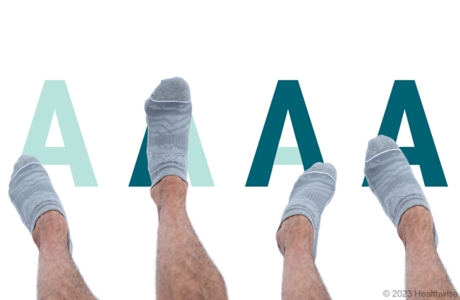
- Sit in a chair with your feet flat on the floor. (You can also do this exercise lying on your back with your affected leg propped up on a pillow).
- Lift the heel of your affected foot off the floor, and slowly trace the letters of the alphabet.
- It's a good idea to repeat these steps with your other foot.
Side-to-side knee swing
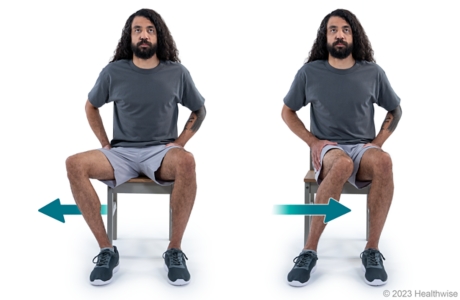
- Sit in a chair with your affected foot flat on the floor.
- Slowly move your knee from side to side. Keep your foot pressed flat.
- Continue this exercise for 2 to 3 minutes.
- It's a good idea to repeat these steps with your other foot.
Towel scrunch

- Sit in a chair, and place your affected foot on a towel on a hard floor (not a floor with carpet).
- Scrunch the towel toward you with your toes. Then use your toes to push the towel back into place.
- Repeat 8 to 12 times.
- It's a good idea to repeat these steps with your other foot.
Make this exercise more challenging by placing a weighted object, such as a soup can, on the other end of the towel.
Calf stretch (seated, knee straight)

- Sit on the floor with your affected leg straight and resting on the floor.
- Place a towel around your affected foot.
- Hold one end of the towel in each hand.
- Pull back gently with the towel so that you feel a stretch in your calf.
- Hold the position for 15 to 30 seconds.
- Repeat 2 to 4 times.
- It's a good idea to repeat these steps with your other leg.
Ankle eversion

- Sit in a chair with your affected foot flat on the floor and next to a wall or a piece of furniture that doesn't move.
- Push your foot outward against the wall or piece of furniture.
- Hold for about 6 seconds, and then relax.
- Repeat 8 to 12 times.
- It's a good idea to turn the chair around and repeat these steps with your other foot.
After you feel comfortable with this, try using an exercise band for resistance instead of a wall. Tie a loop in one end of an exercise band, or hold both ends of the band in one hand. Put the loop around the outside of your affected foot and then step on the band with your other foot. Push your affected foot out to the side against the band, and then count to 10 as you slowly bring your foot back to the middle. Repeat 8 to 12 times. Then it's a good idea to repeat the steps with your other foot.
Ankle opposition (isometric)

- Sit up straight. Put your feet together, flat on the floor.
- Press your affected foot inward against your other foot.
- Then place the heel of your other foot on top of the affected foot. Push up with your affected foot against the heel of your other foot. Your muscles will tighten, but your affected foot should not move up.
- Hold for about 6 seconds, and then relax.
- Repeat 8 to 12 times.
- It's a good idea to repeat these steps with your other foot.
- Hold for about 6 seconds, and then relax.
- Repeat 8 to 12 times.
- It's a good idea to repeat these steps with your other foot.
Resisted ankle inversion
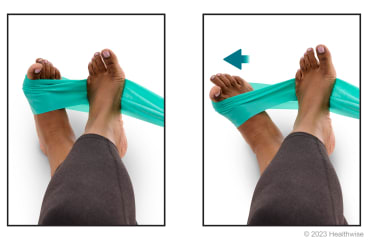
- Sit on the floor with your legs straight out in front of you. Cross your good leg over your affected leg.
- Hold both ends of an exercise band in one hand and loop the band around the inside of your affected foot. Then press your other foot against the band.
- Keeping your legs crossed, slowly push your affected foot against the band so that foot moves away from your other foot. Then slowly relax.
- Repeat 8 to 12 times.
- It's a good idea to repeat these steps with your other leg.
Resisted ankle eversion
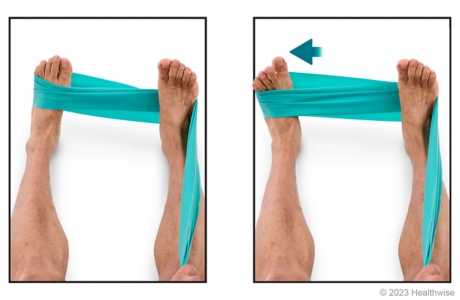
- Sit on the floor with your legs straight.
- Hold both ends of an exercise band in one hand and loop the band around the outside of your affected foot. Then press your other foot against the band.
- Keeping your leg straight, slowly push your affected foot outward against the band and away from your other foot without letting your leg rotate. Then slowly relax.
- Repeat 8 to 12 times.
- It's a good idea to repeat these steps with your other foot.
Resisted ankle dorsiflexion

- Tie the ends of an exercise band together to form a loop. Attach one end of the loop to a secure object, or shut a door on it to hold it in place. (Or you can have someone hold one end of the loop to provide resistance.)
- Sit on the floor or in a chair, and loop the other end of the band over the top of your affected foot.
- Keeping your knee and leg straight, slowly flex your foot back toward you so you are pulling back on the exercise band. Then slowly return to the starting position.
- Repeat 8 to 12 times.
- It's a good idea to repeat these steps with your other foot.
Single-leg balance
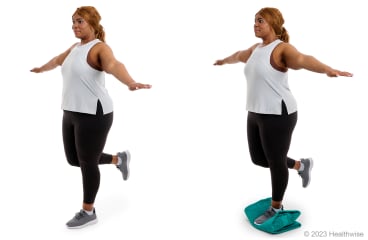
- Stand on a flat surface with your arms stretched out to your sides like you are making the letter "T." Then lift your good leg off the floor, bending it at the knee. If you are not steady, use one hand to hold on to a chair, counter, or wall.
- Standing on your affected leg, keep that knee straight. Try to balance on that leg for up to 30 seconds, and then rest.
- Repeat 8 to 12 times.
- It's a good idea to repeat these steps with your other leg.
When you can balance on your affected leg for 30 seconds with your eyes open, try to balance on it with your eyes closed.
When you can do this exercise with your eyes closed for 30 seconds with ease and no pain, try standing on a pillow or piece of foam.
Current as of: July 17, 2023
Author: Healthwise Staff
Clinical Review Board
All Healthwise education is reviewed by a team that includes physicians, nurses, advanced practitioners, registered dieticians, and other healthcare professionals.

